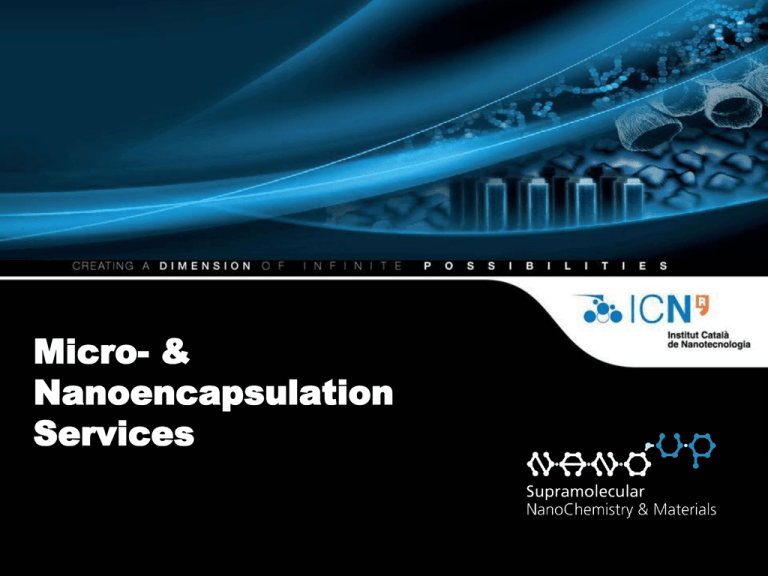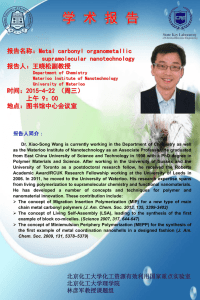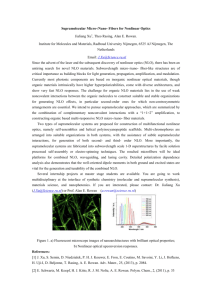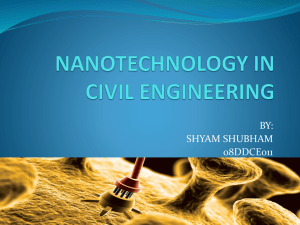presentation - NanoUp Supramolecular NanoChemistry
advertisement

Micro- & Nanoencapsulation Services Presentation About us Micro- & Nanoencapsulation Services Supramolecular NanoChemistry & Materials Group Catalan Institute of Nanotechnology Catalan Institute of Nanotechnology (ICN) The Catalan Institute of Nanotechnology (ICN) is a non-profit private foundation created in 2003 by the Ministry of Universities, Research and Information Society of the Catalan Government (DIUE) and the Autonomous University of Barcelona (UAB). It is part of CERCA, the network of Research Centres launched by the Catalan Government as a cornerstone of its long-term strategy to foster development of a knowledgebased economy. ICN's research lines focus on the newly discovered physical and chemical properties that arise from the fascinating behaviour of matter at the nanoscale. Supramolecular NanoChemistry & Materials The Supramolecular NanoChemistry & Materials (NANOup) group was set up in 2009 by ICREA Research Prof Daniel Maspoch. It comprises 5 senior researchers, 6 PhD students and 1 project manager. NANOup uses supramolecular chemistry to explore new materials and applications (in close collaboration with several private companies) in diverse areas, including microand nanoencapsulation, drug-delivery systems, contrast agents, and novel sensors and magnetic platforms. NANOup team ICREA Prof. Daniel Maspoch Group Leader Dr. Inhar Imaz RyC Researcher Dr. Nereida Mejías Dr. Kyriakos Stylianou Dr. Sonia García Marie Curie Fellow Contracted Post-Doc Senior Technician Marta Rubio ICN Fellow Carlos Carbonell Contracted PhD Àngels Ruyra Ramón Areces Fellow Iván Burneo SENESCYT Fellow Arnau Carné FI Fellow Dr. Mary Cano Researcher Marta González Project Manager Javier Ariñez FPU Fellow Research Lines Nanoscale Supramolecular Materials Supramolecular Nanostructures on Surfaces Micro- and Nanoencapsulation Technologies Micro- and Nanoencapsulation Technologies Packaging micro- or nanoparticles of solid, liquid or gas (the core or active substance) within a secondary material (the matrix or shell), to form nano- or microcapsules The core material is protected by a shell and only delivered when needed. Triggered release (pH, T, pressure) Target release (site recognition) Sustained release (shell decomposition) Functional advantages Protect core material Change properties (increase solubility, mask taste, etc.) Aesthetic improvements Decrease toxicity (reduce required dose; local release) Reduce costs Micro- & Nanoencapsulation Services Our mission: To help private companies and public research institutes to develop novel encapsulation products we provide a complete product development service From the lab to the market: We design and fabricate new products, based on in-house technology, and assist collaborators with scaling-up. Design Development Quality Control Scale-up to Commercial Quantitites Our expertise We have developed diverse types of micro- and nanocapsules to match each industrial sector and application. These differ by their membrane, which is carefully selected to suit the customer’s needs. Depending on the final application, the membrane can be further optimised. Core Shell Hydrophobic liquids Polymers: Aqueous solutions natural (polysaccharides, proteins, etc.), Solids Emulsions synthetic (polyamides, polyesters, polyureas, polyurethanes, urea/melamine-formaldehyde resin, polystyrene, etc.), Dispersions semi synthetic (chitosan, cellulose, starch, etc.) Gases Lipids: cholesterol, phospholipids Inorganic materials: SiO2 Protect core material • Prevent environmental oxidation or deactivation • Separate incompatible materials Modify properties of the core material • Mask organoleptic properties like color, taste, odor of substances • Safe handling of toxic cores Convert liquids to freeflowing solids • Reduce handling costs Controlled and targeted release of encapsulated cores • Improve adhesion, penetration or recognition of tissues and cells • Reduce active doses, and therefore, potential toxicity/side-effects Modify core material via release • Provide sustained release maintain optimal concentration • Provide triggered release based on environmental changes (T, pH) • Marketing & product aesthetics Develop novel products • Enable more stable, efficient and biocompatible products, based on nanocapsules Our capabilities We can encapsulate core materials in different polymer membranes. Encapsulation protects the active component in the core, enables controlled release and reduces or eliminates toxicity. + In-situ, interfacial & radical polymerisation • Melamine-formaldehyde, polyurethane, styrene, polyurea, polyamides, polyesters, silica, ethylcellulose Simple and complex coacervation • Gelatin, acacia and glutaraldehyde • Casein, chitosan, PVA Liposomes & Solid Lipid Nanoparticles • Lipid-cake hydration and homogeneisation by extrusion, ultrasound • Emulsions • Nanoemulsions, double emulsions • Polymeric surfactants Spray-drying • Particle miniaturisation (300 nm to 100µm) • Encapsulate peptides, drugs or food ingredients Our equipment Through specialised facilities—some of which are unique in Spain—we offer high-level technical assistance to collaborate with external partners, including for commercial R&D. Equipment for synthesis Pilot plant Characterisation Nanochemistry Lab Spray-drying Extrusion Rotary evaporator Freezer (-80 ºC) Lyophiliser Ultracentrifuge Nanospray Spray Drier (Büchi) Mini Spray Drier (Büchi) Particle miniaturisation LIPEXTM extruder (Northern Lipids) Liposome preparation at 10 mL scale High pressure homogenisation Pilot plant reactor M-110L Microfluidiser Processor High-shear fluids processing Microfluidics Dispermat CN 0.5 to 40 L Dissolver Bench scale mixers Overhead stirrers Ultraturrax (IKA) Ultrasound probe Full physical characterisation Full chemical characterisation Study of the release IR, UV, Elemental analysis, EDX, TOF-SIMS, X-ray powder diffraction Viscosimeter Direct Visualisation 4 mm SEM TEM Cryo-TEM Rupture force & deformability studies Nanoindentator Porosity studies BET Stability studies Turbiscan Mastersizer Size determination DLS SEM Custom solutions With extensive experience and knowledge in the microencapsulation field, we can solve your technical problems in any industrial sector. We can help you to protect solid particles or liquid droplets and ensure controlled release of the active components. Nutrition Textiles Drugs Construction Cosmetics Agriculture Nanotechnology does not always involve expensive equipment or rare materials: it can often be incorporated into existing industrial processes with minimal capital investment. We are already working with several companies to develop new commercial products and techniques that incorporate Nanotechnology: Fragrance encapsulation for detergents and softeners Biocide encapsulation for paintings Disinfectant encapsulation for clinical surfaces disinfection Enzymatic encapsulation Peptide micronisation Capsules for self-repairing wood Development of encapsulating matrices using metal-organic systems Encapsulation of phage & inmunostimulants in liposomes and in polysaccharide & biocompatible polymers Questions on encapsulation? Feel free to contact us! Thank you for your attention! Group Leader, NANOUP daniel.maspoch@icn.cat Micro- and Nanoencapsulation Technologies Leader, NANOUP mary.cano@icn.cat








